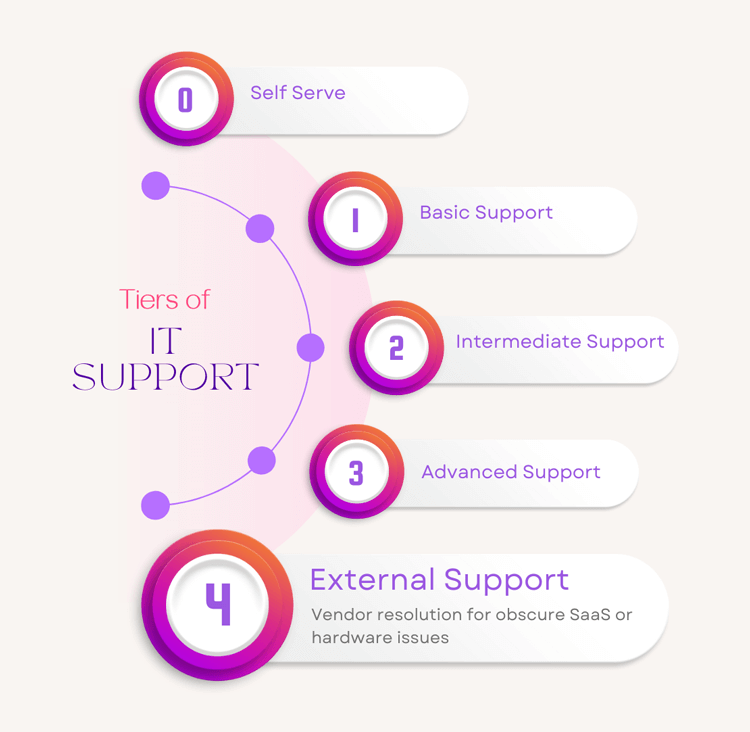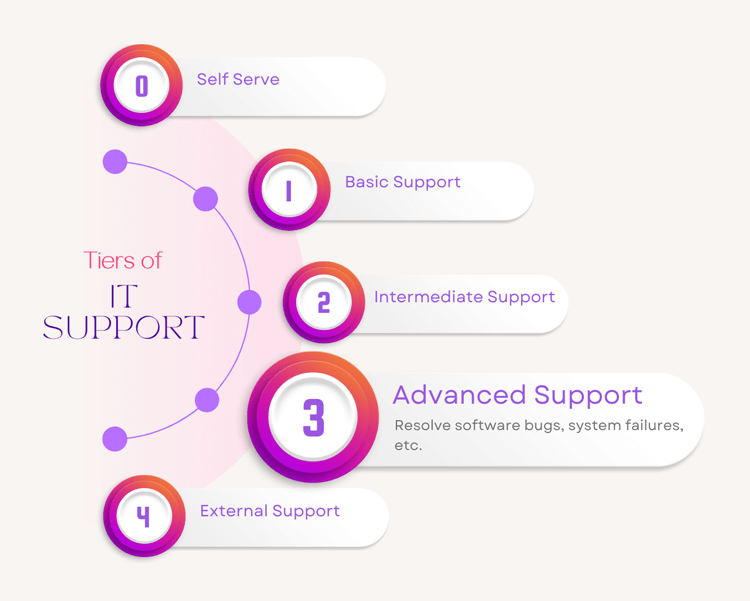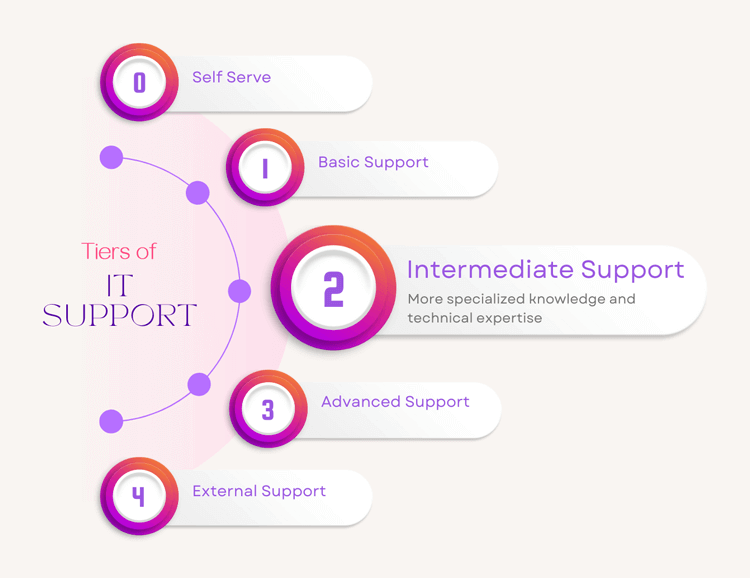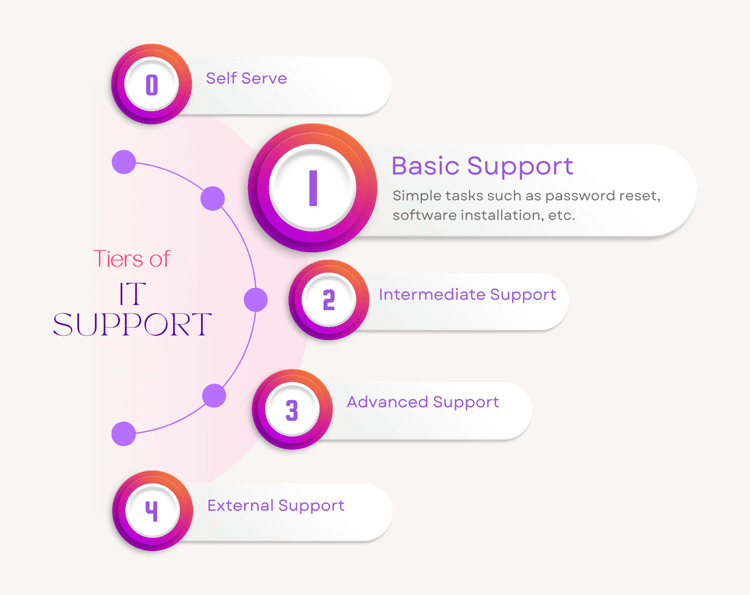Tier 4 IT Support Fully Explained: External Tech Support
Tier 4 IT Support, also known as Level 4 IT Support, is the highest level of support in the IT Service Management (ITSM) system.
Unlike the other tiers, which are typically managed within an organization's internal IT team, Tier 4 support involves external vendors, suppliers, or service providers, such as managed IT services.

TL;DR
- Accessing ITIL user support, usually by submitting a support ticket via help desk software, goes to one of 4 levels of support.
- Level 4, also known as Tier 4, is the highest level of IT support ITSM organizations usually need. Because this support is hyper-specialist, it's necessary to completely outsource this to expert consultants and vendors.
- Tier 4 support is necessary when dealing with problems related to specific hardware, software, or systems that the organization has outsourced to third-party providers.
Read on for details...
What is Tier 4 IT Support (Level 4)?
Tier 4 IT Support, often referred to as Level 4, is the highest layer of IT service management (ITSM). This service is never delivered by an organization's IT department. In most cases, even if you work with a third-party IT customer service team/vendor, Tier 4 is handled by someone else.
Tier 4 is responsible for working closely with these external vendors to ensure that issues are resolved efficiently and that any service-level agreements (SLAs) are met.
Tier 4 is called upon when serious issues occur that require specialized knowledge, equipment, or access to proprietary technologies that are beyond the scope of the internal IT team, even Level 3.
Why Does Tier 4 IT Support (Level 4) Play a Critical Role in ITSM and Help Desks?
Tier 4 IT Support plays a critical role in ITSM and help desks by providing access to specialized expertise and resources that are not available internally.
When a problem escalates beyond the capabilities of the internal IT team, Tier 4 support ensures that the organization can still resolve the issue by working directly with external vendors.
This level of support is particularly important for maintaining the reliability and performance of critical IT systems that rely on proprietary technology or services.
Tier 4 support helps ensure that these systems are made operational again by facilitating quick and effective communication with vendors and service providers.
Including Tier 4 in an ITSM framework ensures that the most complex issues you can imagine don't completely cripple an organization.
Tier 4 also allows IT teams to allocate resources more efficiently, focusing their attention on critical incidents and strategic initiatives. When ITSM teams and ITIL operators keep the resolution of simple, repetitive troubleshooting tasks to Self-serve, Tier 1, Tier 2, and Tier 3, help desk teams can reduce operational costs, and improve overall service levels and customer service scores (e.g., CSAT, NPS, etc).
Pros and Cons of ITSM Tier 4 IT Support
With five tiers of IT support, from self-serve to the most advanced technical support, your organization will benefit from having all five tiers to support your staff. Here are the pros and cons of Tier 4.
Pros of Tier 4 IT Support
- Access to Specialized Expertise: Tier 4 support provides access to highly specialized knowledge and tools that are not available internally. This can also be through a contract-based IT vendor. These all help make sure that complex issues can be resolved.
- Vendor Accountability: Engaging Tier 4 support helps enforce SLAs. It also helps ensure that software and platform vendors meet their contractual obligations. These help reduce the risk of prolonged downtime.
- Cost-Effective Resource Management: By outsourcing certain aspects of support, organizations can avoid the costs associated with maintaining in-house expertise for all possible technologies. Tier 4 is too expensive to maintain internally.
- Focus on Core Competencies: Internal IT teams can focus on core tasks and strategic initiatives while relying on Tier 4 for highly specialized issues. This can help improve operational efficiency.
- Enhanced Problem Resolution: Collaboration with vendors often leads to quicker resolution of issues, as Tier 4 providers are typically the best-equipped to deal with their own products or services.
Cons of Tier 4 IT Support
- Dependency on External Providers: Relying on external vendors can create dependencies, which may lead to delays if the vendor is not responsive or if there are issues with the SLA.
- Much Higher Costs (than Tier 3): Engaging Tier 4 support can be expensive, particularly if the organization frequently relies on external vendors for problem resolution. If that keeps happening, a company might decide it's easier to switch to another vendor or develop an in-house solution that's customized to internal requirements.
- Limited Control: When issues are escalated to Tier 4, the organization will have much less control over the problem-solving process. This can lead to frustrations if the vendor does not prioritize the issue.
- Communication Challenges: Coordination between internal IT teams and external vendors can be challenging, especially if there are language barriers, time zone differences, or misaligned communication protocols.
- Data Security Risks: Involving external vendors may raise concerns about data security, particularly if sensitive information is required to resolve the issue.
Now let's look at how to set up Tier 4 ITSM support, which involves working with an external consultant or certified vendor partner to deliver.
How to Set Up Tier 4 IT Support
In most cases, setting up Tier 4 IT Support involves 5 stages; although the responsibility for setting this up is usually an external vendor or consultant.
You just need to ensure it integrates with internal processes and systems and the other levels of IT support, especially Tier 2 and Tier 3.
- Identify Critical Systems and Technologies: Determine which systems and technologies are critical to your organization's operations. Then, identify the external vendors or service providers responsible for supporting these systems.
- Establish Vendor Relationships and SLAs: Develop strong relationships with your vendors and negotiate clear SLAs that outline response times, resolution times, and other critical performance metrics. Ensure that these agreements are documented and understood by both parties.
- Create a Vendor Escalation Process: Design a clear escalation process that specifies when and how issues should be escalated to Tier 4 support. This process should include contact information for key vendor team members/account managers, and protocols for communication.
-
Train Internal Teams on Vendor Engagement: Train your internal IT teams on how to effectively engage with external vendors. This includes:
- Understanding the SLAs
- Knowing when to escalate issues
- Knowing how to document and communicate problems to the vendor
- Monitor Vendor Performance: Regularly review vendor performance against the SLAs and address any issues that arise. This can include conducting periodic performance reviews and working with vendors to improve service delivery.
How Does Tier 4 Compare to Other ITSM Support Tiers?
For more information on every tier of IT support, here is our 5 Tiers of IT Support Explained: Tier 0 to Tier 4, ultimate guide.
Tier 4 vs Tier 0 (Self-Serve)
Tier 0 is user-driven, relying on self-service tools and resources, while Tier 4 involves expert intervention for resolving complex technical issues. Tier 0 focuses on empowering users, whereas Tier 4 focuses on the highest level of problem-solving and system improvements.
For more information on Tier 0, self-serve support, here's our article on Tier 0 (Level 0) IT Support.
Tier 4 vs Tier 1
Tier 4 support is for the most complex issues that require deeper technical knowledge, and vendor expertise.
While Tier 1 handles simple, routine troubleshooting as the front line of every IT help desk, Tier 4 IT vendors/consultants solve problems that require the most advanced and specialized knowledge.
For more information on Tier 1 support, here's our article on Tier 1 (Level 1) IT Support.
Tier 4 vs Tier 2
Tier 2 focuses on solving less complex technical challenges; although ones that are still more complex than Tier 1 can handle.
Tier 4 comes into play when Tier 2 and even Tier 3 cannot resolve an issue and require external vendor involvement.
For more information on Tier 2 support, here's our article on Tier 2 (Level 2) IT Support.
Tier 4 vs Tier 3
Tier 3 support deals with the most complex internal issues, typically involving senior IT staff or engineers. However, when an issue requires vendor-specific knowledge or resources, it is escalated to Tier 4, which involves external expertise.
For more information on Tier 3 support, here's our article on Tier 3 (Level 3) IT Support.
How Do Different Tiers of IT Support Work Together to Make a Functional ITSM Team?
The different tiers of IT support work together to create a seamless, efficient support ecosystem.
Tier 0 empowers users to solve their own problems, reducing the burden on IT staff.
Tier 1 serves as the first point of contact, handling basic issues and escalating more complex ones to Tier 2.
Tier 2 tackles intermediate challenges and escalates the most difficult cases to Tier 3.
Tier 3, with the most skilled technicians, tackles the most complex and critical issues, sometimes working with Tier 4 (external support) when necessary. Tier 4 engages external vendors when specialized knowledge is required.
Key Takeaways: Why Your Organization Needs Tier 4 IT Support
Tier 4 IT support is essential for organizations that rely on external vendors for critical systems and technologies. It provides access to specialized expertise, ensures vendor accountability, and helps resolve complex issues that cannot be managed internally.
When you have Tier 4 support as part of your ITSM strategy, your organization can enhance problem resolution, maintain high service levels, and ensure that your IT infrastructure remains robust and reliable.
Giva Can Help Streamline Your Tier 4 IT Support
Giva's help desk and ITSM software bring you real-time, highly-customizable dashboards with a large widget library. You'll be up and running in days, and your IT help desk and service desk teams can be trained in hours on our intuitive and friendly interface.
Other Giva features include:
- Harness the power of Giva's AI Copilot to effortlessly refine responses and quickly access and format solution information
- Automatically convert emails into tickets to streamline the ticketing process
- Customize Giva for any department or subsidiary organization and deliver real-time agent and team analytics to help improve performance
- Automatically open tickets on a scheduled and recurring basis
- Automate escalation and closure of tickets
To learn more, book a free Giva demo to see our solutions in action, or start your own free, 30-day trial today!





